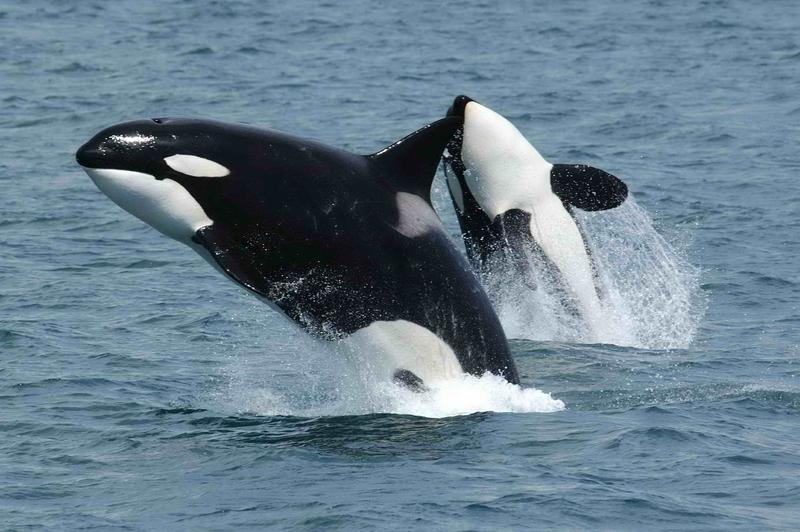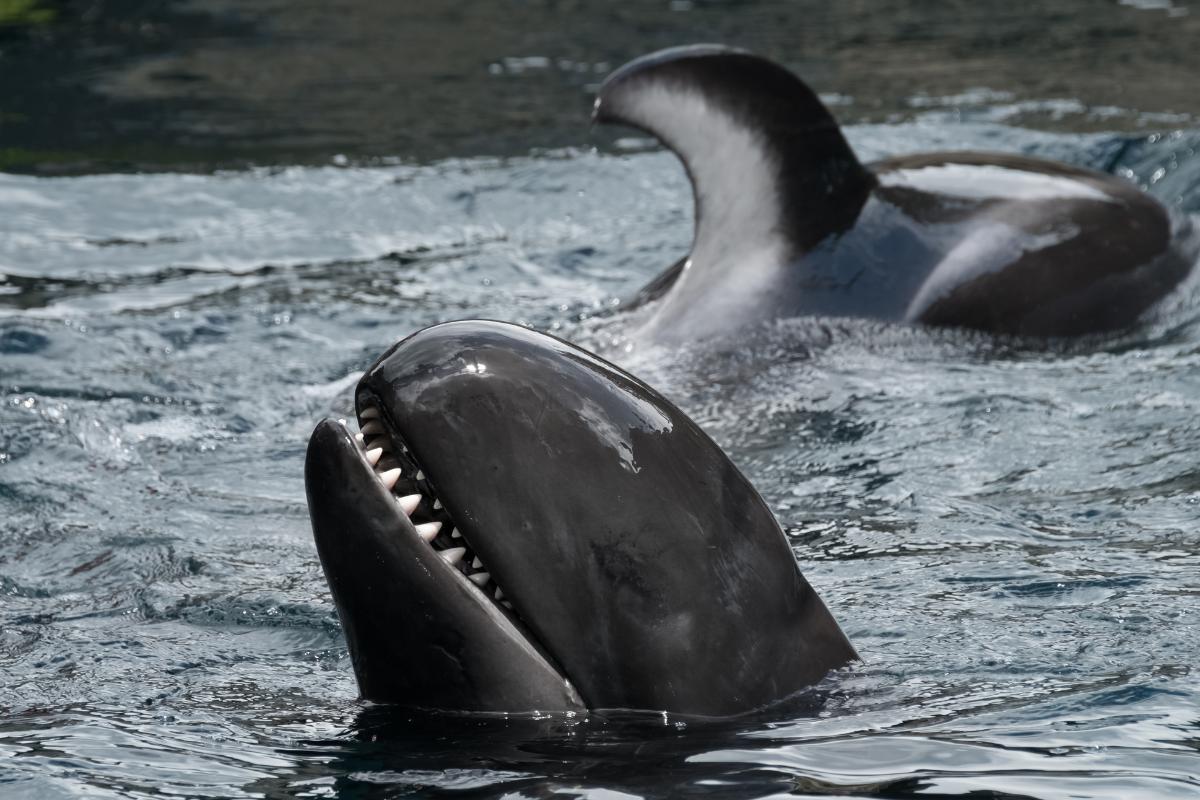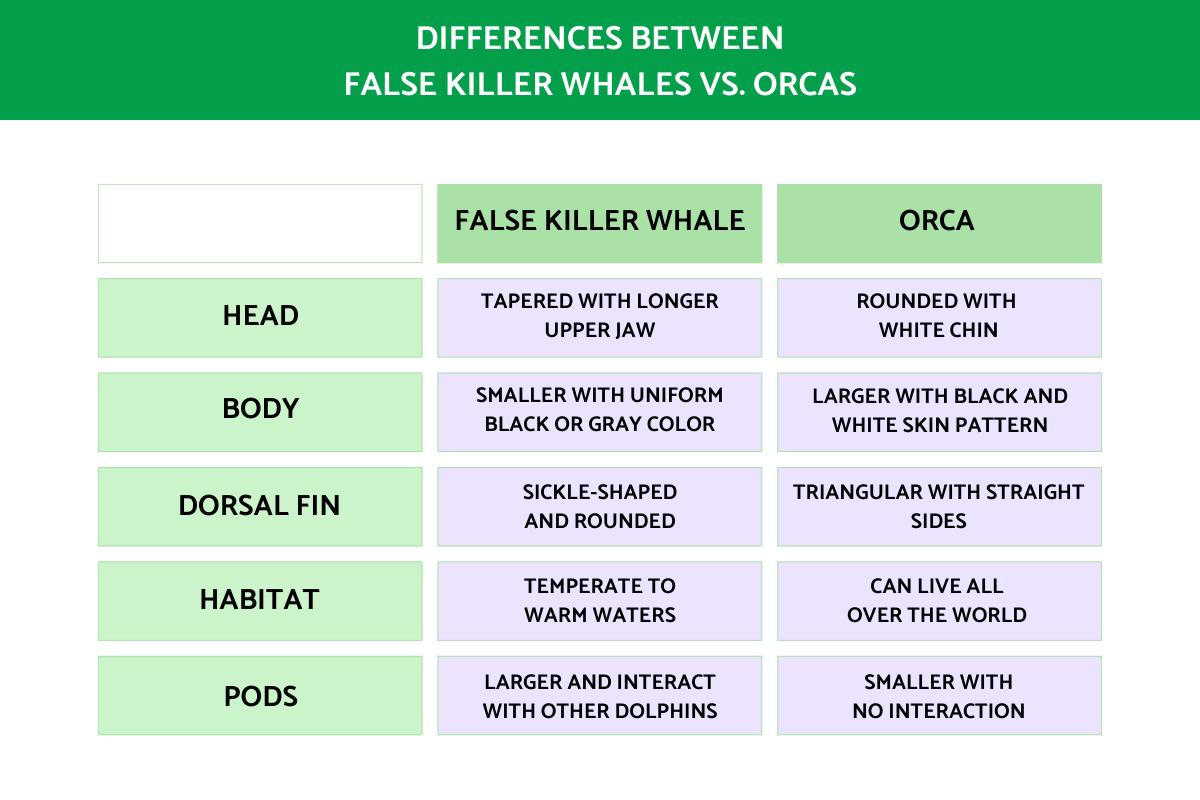Difference Between False Killer Whale vs. Orca


The differences between false killer whales and orcas are not only taxonomic, but also physical and behavioral. Orcas are also known as killer whales, a name indicative of their incredible skill as hunters. While false killer whales are their own animal, their similarity in appearance has led many to confuse one species with the other. Both are cetaceans, meaning their are part of an infraorder of aquatic mammals known as Cetacea. This group includes whales, dolphins and porpoises. Despite their names, orcas and false killer whales are actually types of dolphin. They share many similarities, but there are certain key differences we can use to distinguish them.
At thedailyECO, we look at these differences by making a comparison between the false killer whale vs. orca. We do so by explaining the physical and behavioral differences between these dolphins, as well as providing photos to see the differences for ourselves.
Main characteristics of the orca (Orcinus orca)
The killer whale or orca (Orcinus orca) is the only member within its genus belonging to the family Delphinidae It is the largest species in the dolphin family, one of the reasons it is often confused with whales.
General characteristics of the orca
The killer whale is one of the easiest marine animals to recognize, not only because of its size. Their skin has a very distinctive black and white pattern which can be seen from quite a distance. From above, we only see black. As you can see in the photo below, the white part is only visible on the underside of their body and mouth, except for a white oval patch near each eye.
The orca has a triangular shaped dorsal fin which can reach up to 6.5' (2 m) in height. This can become disfigured due to fights or hunting, although it is particularly common for orcas in captivity to have bent fins. They use a large caudal fin to reach high velocities under water, some swimming as fast as 31 mph (50 kph). Generally speaking, orcas measure up to 32.8' (10 m) in height, although even large specimens have been recorded.
As with other types of dolphin, it is common to find killer whales swimming in the company of members of the same group. This group is known as a pod and can have as many as 20 individuals. The reasons for orcas to swim in pods include protection, benefits from group hunting and finding a mate. The orca has a very cosmopolitan animal distribution and inhabits oceans all around the world.
Orca diet and hunting
Since these animals are named after their ability to kill, it is no surprise they are very good at it. We may think of the great white shark as being the most dangerous animal in the sea, but it is the orca which is considered the apex predator. Not even a great white is a match for a killer whale. In fact, the orca is known to hunt killer whales for food.
Killer whales hold onto their prey thanks to their teeth which can be upwards of 3" (8 cm) in length. These teeth are used to kill and tear, but they do not chew. Prey ranges from small fish to larger animals such as whales, sharks and other dolphins. Generally, their main prey is seals and large fish. Killer whales do not usually attack humans or boats they encounter. They only do so when threatened.
Orca mating and reproduction
Orcas usually breed in late winter and early spring when they seek out warmer waters. To attract females, males often make sounds such as whistles. When mating begins, the two killer whales separate from the group and begin to touch each other with their snouts before mating. The gestation period usually lasts up to 16 months. Usually one calf is born at a time. These calves can be up to 6.5' (2 m) in length and weigh around 400 lb (180 kg).
Check out another comparison of different marine animals with the difference between squid vs. cuttlefish.

Main characteristics of the false killer whale
Also known as the black killer whale, the false killer whale (Pseudorca crassidens) is a much less well-known species belonging to the Delphinidae family. This family also contains orcas. The Latin name of this species means ‘false orca’ which is the direct translation of its common name. They are the only species within their genus.
General characteristics of the false killer whale
These marine mammals have an elongated body with a tapered head and a prominent upper jaw. This can protrude over the lower one, as the photo below depicts. The coloration of their bodies is usually uniform with tones ranging from dark gray to black.
The false killer whale has a dorsal fin which measures up to 12" (30 cm) in height. The end of this fin can be pointed or rounded and it curves backwards in a sickle shape. This is also seen in the photo below. The lateral fins are usually pointed and are at a 45 degree angle to the body.
The false killer whale is the third largest dolphin in the world, with an average length of 18' (5.5 m) for males and 15' (4.5 m) for females. Their young usually reach up to 5' (1.5 m) at birth.
False killer whale behavior
The false killer whale is a very active, playful and vigorous marine mammal. This species is characterized by swimming close to boats, near the prows and by playing by jumping and hitting the water with its tail.
They usually travel in groups of between 10 and 60 individuals, forming pods that maintain close ties between them. They can sometimes even incorporate individuals from other pods.
False killer whale diet and habitat
Their diet is based on fish such as tuna or cod, and squid. Although not as adept hunters as killer whales, they are also known to kill and eat other cetaceans smaller than them. They mostly inhabit oceanic waters with temperate to warm temperatures. These are usually in deep waters.

Main differences between false killer whales vs. orcas
The reason species Pseudorca crassidens is so called is due to their resemblance to orcas. They also have key similarities such as their use of echolocation. However, there are many key differences which can help us to differentiate between these two species of dolphin. The differences between a false killer whale vs. orca include:
- Head: orcas have round heads with a noticeable white patch underneath the chin and two oval white patches near the eyes. False killer whales have a head which tapers into a narrow end, has an upper jaw which can stick out and is uniform in color.
- Body: the false killer whale also has a body of uniform color which can be black, but is usually lighter than the black of orcas. Orcas have a distinct black and white skin pattern. Orcas are significantly larger than false killer whales.
- Teeth: both animals have conical teeth, but those of orcas are longer and interlocking. Orcas can have up to 56 teeth and false killer whales have 44.
- Dorsal fin: false killer whales have a more curved dorsal fin which is sickle shaped and slightly curved at the top. Orcas are usually a little more pointed and triangular dorsal fin with straighter sides.
- Hunting ability: while false killer whales are adept hunters, they do not deploy the same level of skill as orcas. Orcas are known to even partly beach themselves on shore to catch seals and will even break up ice floes for hunting. Although orcas can hunt at great depth, they tend to do so around 65.6' (20 m) depth[1]. False killer whales usually hunt at greater depths.
- Pods: false killer whale pods are usually larger than those of orcas. False killer whales will also swim in groups with other types of dolphin, something which is not common with orcas.
- Habitat: orcas live in waters all across the globe with varying temperatures. False killer whales tend to only live in temperate or warm waters.
- Population: although we do not know the exact population numbers of orcas, we do know they have larger overall populations compared to the false killer whale. In fact, it was once thought the false killer whale was extinct at one point.
As you can see, there are some key differences between orcas vs. false killer whales. Another key factor is that orcas will prey on false killer whales given the chance. Since the orca is larger and a better hunter, the false killer whale will most likely avoid an orca if they swim in the same waters.
Learn more about this group of marine mammals with our article on do dolphins get high with puffer fish?

If you want to read similar articles to Difference Between False Killer Whale vs. Orca, we recommend you visit our Facts about animals category.
1. Aguilar de Soto, N., Visser, F., Tyack, P. L., Alcazar, J., Ruxton, G., Arranz, P., Madsen, P. T., & Johnson, M. (2020). Fear of Killer Whales Drives Extreme Synchrony in Deep Diving Beaked Whales. Scientific reports, 10(1), 13.
https://doi.org/10.1038/s41598-019-55911-3








